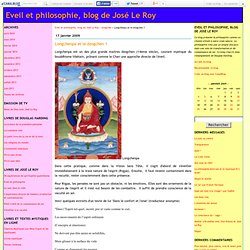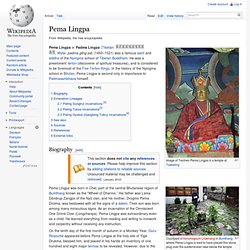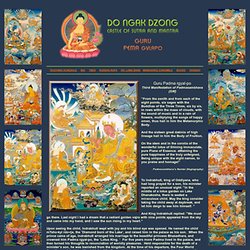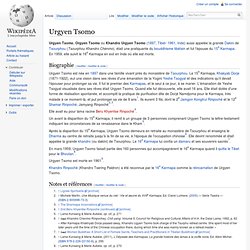

Jamgon Ju Mipham Gyatso. Longchenpa et le dzogchen 1. Longchenpa est un des plus grands maitres dzogchen (14ème siècle), courant mystique du bouddhisme tibétain, prônant comme le Chan une approche directe de l'éveil.

Longchenpa Dans cette pratique, comme dans la Vision Sans Tête, il s'agit d'abord de s'éveiller immédiatement à la vraie nature de l'esprit (Rigpa). Ensuite, il faut revenir contamment dans la vacuité, rester consciemment dans cette présence. Pour Rigpa, les pensées ne sont pas un obstacle, ni les émotions. Elles sont des ornements de la nature de l'esprit et il n'est nul besoin de les combattre. Voici quelques extraits d'un texte de lui "Dans le confort et l'aise" (traducteur anonyme) "Dans l’Esprit-tel-quel, incréé, pur et vaste comme le ciel, Les mouvements de l’esprit ordinaire (Concepts et émotions) Ne doivent pas être saisis ni solidifiés, Mais glisser à la surface du vide Comme se dispersent les nuages.
Longchenpa. Padmasambhava - 8 Forms: Pema Gyalpo (Himalayan Art) Pema Gyalpo Padmasambhava (Tibetan: pe ma gyal po, pe ma jung ne, English: Lotus King, Lotus Born): from the set of Eight Manifestations of Padmasambhava.

In royal attire with long flowing garments of various colours, a headdress of silk, long sleeves and shoes, he holds up in the right hand a double sided drum (Sanskrit: damaru) and in the left held to the side a gold mirror. Adorned with a crown of gold, earrings and necklace he is seated in the relaxed posture of 'royal ease' atop an ornate throne with the left leg drawn up and the right extended resting on a lotus cushion supported by a single lion.
Wishing jewels and precious objects are arranged in front. At the left side, two senior dignitaries richly clad in fine clothes, offer ceremonially a long white scarf. Guru Pema Gyalpo. Pema Lingpa. Image of Terchen Pema Lingpa in a temple at Tsakaling Pema Lingpa or Padma Lingpa (Tibetan: པདྨ་གླིང་པ་, Wylie: padma gling pa) (1450–1521) was a famous saint and siddha of the Nyingma school of Tibetan Buddhism.

He was a preeminent terton (discoverer of spiritual treasures), and is considered to be foremost of the Five Terton Kings. TULKOU DO KHYENTSE RINPOCHE - Moulins à prières. Mythologie tibetaine: Padmasambhava. Pema gyalpo. “From the zenith and from each of the eight points, six sages with the Buddhas of the Three Times, six by six, in rows within the mass of clouds, with the sound of music and in a rain of flowers, multiplying the songs of happy omen, thus hail in him the Metamorphic Body.

And the sixteen great dakinis of high lineage hail in him the Body of Fruition. Urgyen Tsomo. Un article de Wikipédia, l'encyclopédie libre.

Urgyen Tsomo, Orgyen Tsomo ou Khandro Urgyen Tsomo (1897, Tibet- 1961, Inde) aussi appelée la grande Dakini de Tsourphou (Tsourphou Khandro Chènmo), était une pratiquante du bouddhisme tibétain et fut l'épouse du 15e Karmapa. En 1959, elle suivit le 16e Karmapa en exil en Inde où elle est morte. Biographie[modifier | modifier le code] Urgyen Tsomo est née en 1897 dans une famille vivant près du monastère de Tsourphou. Le 15e Karmapa, Khakyab Dorje (1871-1922), eut une vision dans ses rêves d'une émanation de la Yogini Yeshe Tsogyal et des indications qu'il devait l'épouser pour prolonger sa vie. Elle avait eu pour lama racine Beru Khyentse Rinpoché[4]. Un avant la disparition du 15e Karmapa, il remit à un groupe de 3 personnes comprenant Urgyen Tsomo la lettre-testament indiquant les circonstances de sa renaissance dans le Kham[5].
Urgyen Tsomo est morte en 1961[9]. Notes et références[modifier | modifier le code] Female Dharma Masters. Khandro Rinpoché. Un article de Wikipédia, l'encyclopédie libre.

Jetsün Khandro Rinpoché Khandro Rinpoché ou Khandroma Tsering Paldron Rinpoché, (née le 19 août 1967) directrice du monastère Samten Tse (Inde), est la fille de Mindroling Trichen, chef de l'école Nyingma du bouddhisme tibétain, un des lamas tibétains les plus renommés vivant aujourd'hui. Née dans la lignée de Mindroling, qui dans toute son histoire a eu beaucoup de maîtres femmes accomplies, Khandro Tsering Paldrön a été identifiée à l'âge de deux ans par le 16e Karmapa comme réincarnation de la Grande Dakini de Tsourphou, Khandro Urgyen Tsomo, une des maîtres femmes les plus renommées de son temps.
La présente Khandro Rinpoché détient les lignées des traditions Nyingma et Kagyu. Her Eminence Mindrolling Jetsün Khandro Rinpoche.